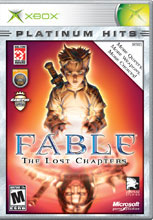|
The story blends both a quest for vengeance and a typical save-the-world scenario to produce an adventure that is both exciting and engaging, while never feeling cliche.
The morality system seems simultaneously overwrought and underused. The choices are always cut and dried, offering only black and white decisions. The AI makes certain that you know your standing with them at all times. The problem, though, is that, as far as I can tell, the main storyline proceeds in much the same way regardless of your moral choices. This is weaker than KOTOR, which supplied enough variation between Light and Dark sides so that it practically included two different adventures.
One aspect of the morality system that was particularly frustrating: barrels. It was impossible to know exactly whether a barrel would give a negative morality hit or not. Some were obvious because they were inside a building or structure owned by someone else. Others were not so clear. Obviously this only matters if you are playing as the good guy, which seemed odd. Where were the barrels that would give a morality bump UP when broken to confuse players on the evil track?
Greg Kasavin said in his review that the combat seems largely broken if you use particular magic powers. I believe he is referring to the bullet-time effect (slowing time for enemies). Assuming that is true, I do not agree 100%. While it does make some enemies easy to kill, in other cases, it is the only way to land hits without getting pummeled. The reason is most of the enemies in the latter parts of the game have very fast attacks, which interrupt all of the player's attacks. Without bullet-time, the player would likely take quite a bit of damage from grunt enemies. Of course, huge stockpiles of health-regenerating food in your inventory can counter the effects of any amount of damage, but that is a different issue.
Two mechanics I really enjoyed were digging and fishing. Digging challenges you to see the locations where things were burried, which requires a sharp eye in some cases. Fishing was a fun diversion as a mini-game. Moreover, the design made it very clear from the beginning that those bubbling areas in the water meant something (I knew that I just needed a fishing pole!).
Spoiler Alert: do not read this paragraph if you do not want to hear about it. One important note about combat: the last boss. I played God Hand right before Fable. Since Fable came out first, I can only assume God Hand took inspiration from Fable, but the final battle is nearly identical. In both fights, the boss is huge. You are in a circular area and the boss only exists on the edge, exposing mostly just its head for you to attack. In both cases, it fires predictable attacks while on the edge, then exposes itself to a few hits. It moves around the ring, out of range, attempting to reappear out of view. It periodically spawns a couple of minions to annoy you. However, one big difference separates the two fights. It took me two hours to finally beat the boss in God Hand. I beat the one in Fable on the first attempt.
Aesthetically, Fable looks great. The environments are beautiful and diverse. The towns are vibrant and bustling with activity. Your Hero looks good regardless of the outfit he wears or direction your take him, whether as a Will user, assasin, or huge hulking warrior (my favorite). The use of murals on the church walls to convey important milestones in the story was a nice touch, especially seeing them during the credits.
From a technical perspective, Fable had some issues. First and foremost, loading times. Lots of games have loading screens, but this game had them everywhere! The targeting system also gave me headaches. If it was not failing to lock on, it was losing a lock-on and giving no indication that this had occured, or spinning the camera around to face away from the fight. I found some combat issues where enemies would just stand out of range of your melee weapon; if you did nothing, they did nothing. I also ran into a bug related to an infinite spawning point. I detest infinite spawns, so this was a great example why they are bad. Another spoiler: skip the rest of this paragraph or read on to hear the details. In the fight against Maze, the town is divided into a lower and upper portion. After fighting in close quarters for a short time, Maze went to the lower portion, while I was on the upper portion. Not sure of his location, I went to the farthest edge of the upper part of town, where I encountered a spawn point for a minion that plagues you during the fight. Since my weapon could kill the minion in one shot, I did just that, over and over and over. I finally quit and went off to find Maze (who never came looking for me) and finish the fight. Afterwards, I received millions of bonus points from killing the minion so many times and I could have just upgraded every single stat to the max.
Despite the aforementioned issues, the aesthetic and the story swept me away. As the images of my adventure slid past the screen during the credits, I reflected on the story and on my life in the game. It was a tale that, like other games, ended with me saving the world, but also one that, unlike most other games, gave me a place in the larger context of the world and let my personal story of revenge and justice carry more weight.
|


